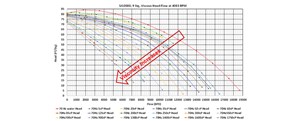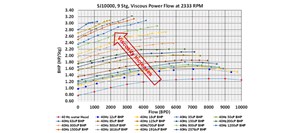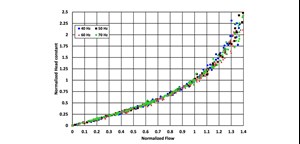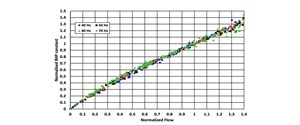Prediction of viscosity correction factors for ESP in viscous applications
Numerous factors affect electric submersible pump (ESP) performance, including operating speed and the produced fluid viscosity. The American Petroleum Institute Recommended Practice (API RP) 11S2 for Electrical Submersible Pump Testing provides guidance for ESP manufacturers to evaluate ESP pumps with water (having a viscosity of 1 cP) at either 50 or 60 Hz. Because water performance can be easily calculated for different speeds in the operation using affinity laws, ESP sizing is generally based on the baseline performance numbers produced during initial API testing.
In practice, predicting ESP performance in viscous applications is complicated because the well fluid produced by an ESP can be more dense than water, with viscosities as high as 1000+ cP. As a result, flow capacity calculations are often underestimated because viscosity affects the pump flow, head, horsepower, and operation at different speeds. Based on these factors, the use of 1 cp fluid results in the pump and motor sizing inaccurate for the actual operating fluid conditions. In challenging offshore applications, producers must develop mitigation strategies early as sizing error issues are exacerbated due to logistics and the higher operations costs. Water flood projects are also at greater risk as emulsion from water flooding can change viscosity significantly and affect ESP sizing.
When applications require operation at speeds varying from 40 to 75 Hz, affinity laws cannot be effectively applied. If used in a viscous application, pump performance accuracy will be severely compromised. Given the viscosity of the typical produced well fluid, the calculated values for flow and head are often low, while horsepower values are high.
Proper sizing of ESPs is important for reliable and efficient production operations. The ESP industry employs a variety of methods and tools to correct for predicting the performance and size of the ESP and motor for viscous applications, including Stepanoff, Gullich, Hydraulic Institute data, experience and rule-of-thumb approximations, and other correlations. These predictions may not be accurate and frequently result in values with errors of +/-25%. The subsequently undersized equipment designs affect the flow limitations, number of pump stages, and horsepower required by each stage. Designs with smaller pumps, smaller motors, or both yield limited production and reduced revenue.
The ESP industry has typically developed viscosity correction factors when a tender is required, or an order is received. In this reactive approach, the selected pump is tested in a viscous test loop with a range of viscosities and at different speeds. Experts use several techniques to collect and curve fit data for various flow rates and corresponding head and horsepower, and then use the corresponding data for sizing. However, in this time-consuming, costly process, the viscosity correction factors generated for one pump cannot be applied to another.
NOVEL SOLUTION
Summit ESP, a Halliburton Service, has taken an innovative and proactive approach. We apply a new pump testing methodology to develop a proprietary viscosity correlation that can be used to accurately size ESPs and motors in real time without the need for costly and inefficient testing of each unique design configuration.
To collect data for the correlations, Halliburton designed and built a state-of-the-art facility to test ESPs in viscous applications at various speeds. Experts can test pumps up to 35,000 bpd in viscosities up to 2,500 cP, at speeds ranging from 30 to 75 Hz. Four different test oils provide viscosities from 5 cP to 2,500 cp in temperatures ranging from 70° to 140°F. The drive motor is rated for 600 HP at 3,500 rpm and is controlled by a variable speed drive for changing speeds. Test oil temperature is maintained constantly by cooling through heat exchangers. Inlet viscosity is measured by an inline viscometer and verified by temperature.
The steady-state, time-stamped pump performance data is collected and the effects of viscosity and operating speed on flow, head, and horsepower for various pumps are observed. Similar conclusions to those reached with past testing performed by various researchers, manufacturers, and universities included: 1) Pump flow and head reduces with an increase in viscosity; 2) Pump bottom hole pressure (BHP) increases with an increase in viscosity; and 3) At a constant viscosity, as the speed increases, the correction factors for head, flow and horsepower reduce as compared to those at lower speeds. In other words, an increase in the viscosity deteriorates pump performance by reducing head flow and increasing horsepower, while an increase in pump rotational speed reduces the rate of deterioration at a fixed viscosity. This means increased operating speeds improve the performance of an ESP in viscous applications.
Additionally, diameter and specific speed effects (a “dimensionless” number for pump design criteria) on viscosity are being investigated as design criteria. A correlation developed for the effects of speed on viscosity correction factors will yield viscosity correction factors that can be used with pumps of different diameters operating at different speeds and viscosities based on a specific speed relationship.
Figures 1 and 2 show pump performance for 538 series SJ10000 pumps. Figure 1 shows head flow performance at 70 Hz (4,083 RPM) and up to 1,750 cP viscosity. As viscosity increases at a given fixed speed, the flow and head capacity are reduced. The red curve represents the water performance having viscosity of 1 cP and other curves show higher viscosities up to 1,750 cP.
Figure 2 shows brake horsepower flow performance at 40 Hz (2,333 RPM) and viscosities up to 2,376 cP. As viscosity increases at a given fixed speed, the flow capacity is reduced, and horsepower is increased. The blue curve with red dots shows the performance of water with a viscosity of 1cP. Other curves are for higher viscosities, which are known as the” viscosity effect.”
Additionally, pump performance improves as speed increases in viscous applications. This means that as the speed increases, the performance deterioration due to an increase in the viscosity reduces, compared to the lower speed. In other words, less correction is required for the head, flow and horsepower for a pump operating at a higher speed than a pump running at a lower speed at a constant viscosity. This is the “speed effect.”
Within the test facility, pumps were tested at 40, 50, 60, and 70 Hz and at various viscosities up to 2,500 cP with performance data continuously collected. The results included four sets of data for head and horsepower-flow performances with over 80 curves for each characteristic. Summit researchers and engineers faced a challenge: how to combine the data into one characteristic curve that can be developed from baseline water characteristics.
Defining dimensionless numbers. To accomplish this, engineers created and patented an innovative process using two new dimensionless numbers for head-flow and horsepower-flow characteristics. The first is called Ketan’s Viscous Head number and is a ratio of flow capacity to the product of head and viscosity at a given speed. This is a measure of viscous flow produced by a pump to the product of head and viscosity at constant speed.
The second dimensionless number is called Ketan-Robert’s Viscous BHP number and is a ratio of flow rate to the brake horsepower, speed, and viscosity. This relationship can be developed using either of the following two equations.
In addition to the development of these new dimensionless numbers, Summit ESP scientists and researchers used a new, innovative approach of normalization that allowed for all viscosity curves at various speeds to be represented by a single curve. This is shown in Figures 3 and 4 for head and brake horsepower, respectively. The accuracy of the prediction is within +/- 5% in the operating range.
These two relationships represent pump performance at all viscosities and speeds. The distinguishing benefit is that they can be generated from the baseline water performance values. With this innovative approach, pump performance at any given viscosity and speed is accurately predicted in the operating range from the water performance. This eliminates the costly testing required for the prediction of the viscous pump performance for each unique ESP design.
Summit ESP scientists and engineers are also developing a new correlation of specific speed with normalized parameters and viscosity, which uses the previously mentioned techniques to accurately predict viscous pump performance of any pump at any flowrate, viscosity, and speed.
CONCLUSIONS
Pump manufacturers need to supply guidelines to predict the performance and sizing of multi-stage pumps in viscous applications. Stage-by-stage performance calculations of multi-stage pumps are recommended for viscous flow applications. Viscosity should be calculated from the first stage as a one-stage pump, corrected by temperature rise and then used for the second stage et.al.
Pumps should be run at the highest possible operating speed for viscous conditions, considering thrust, NPSH, operating flow range, efficiency, and erosion. Pump performance improves with speed in the viscous application.
Pump head and BHP performance and its sizing within the operating range in viscous application can be accurately calculated from the water performance using the proprietary relationships. Accurate pump sizing will improve production bottlenecks and increase ESP reliability resulting from approximate sizing.
NOMENCLATURE
BEP = Best efficiency point
BHP = Brake horsepower
p = pressure
Q = Volumetric flow rate
q = Mass flow rate
ω = Rotational speed (rpm, revolutions per minute)
μ = Absolute viscosity
ν = Kinematic viscosity
REFERENCES
- U.S. patent U.S. 11340103 B2 - Method of calculating viscous performance of a pump from its water performance characteristics and new dimensionless parameter for controlling and monitoring viscosity, flow and pressure.
- U.S. Patent 11378474 B2 - Predict brake horsepower for a pump for viscous applications.
- Sheth, K.K., R.C. DeLong, “Prediction of viscosity correction factors for ESP in viscous application,” SPE paper 209833- MS presented at the SPE Artificial Lift Conference and Exhibition, Galveston, TX, August 23-25, 2022.
- ANSI/HI Standard 9.6.7 “Effect of liquid viscosity on pump performance,” 2004.
- Stepanoff, A. J., “Centrifugal and axial flow pumps,” 2nd Edition, John Wiley & Sons. pp 307-318, 1957.
- Gulich, J. F., “Pumping highly viscous fluids with centrifugal pumps – Part 1 & 2,” World Pumps, August 1999.
- Patil, A., G. Morrison, A. Delgado, H. Casillas, “Centrifugal pump head prediction using affinity laws modified for viscosity,” SPE paper 190926-MS, presented at the SPE Artificial Lift Conference and Exhibition - Americas, August 2018.
- What's new in production (February 2024)
- U.S. operators reduce activity as crude prices plunge (February 2024)
- U.S. producing gas wells increase despite low prices (February 2024)
- U.S. oil and natural gas production hits record highs (February 2024)
- Dallas Fed: E&P activity essentially unchanged; optimism wanes as uncertainty jumps (January 2024)
- Enhancing preparedness: The critical role of well control system surveys (December 2023)








